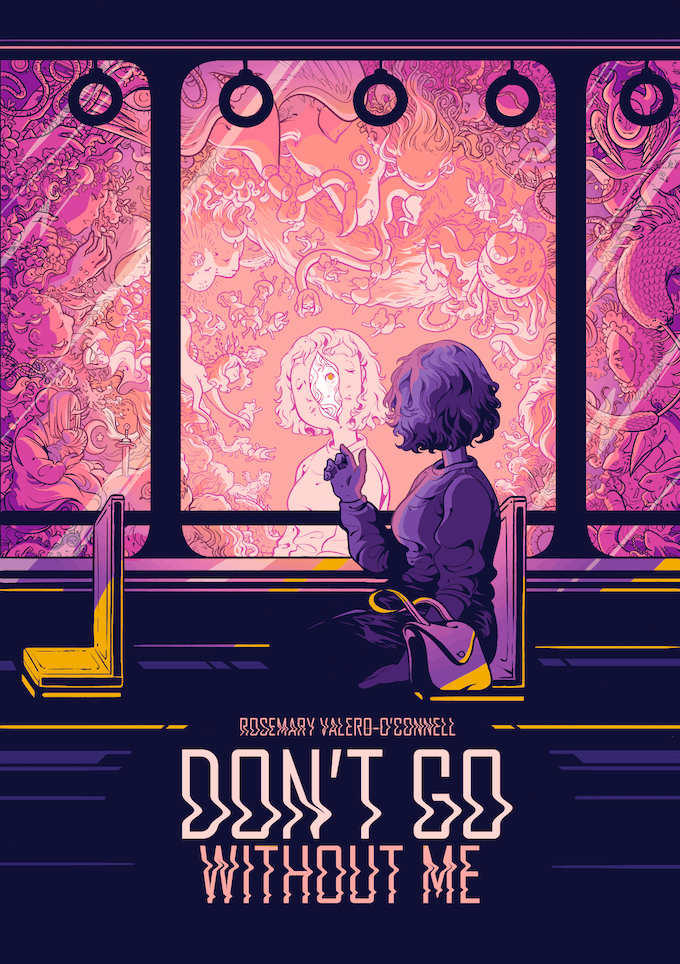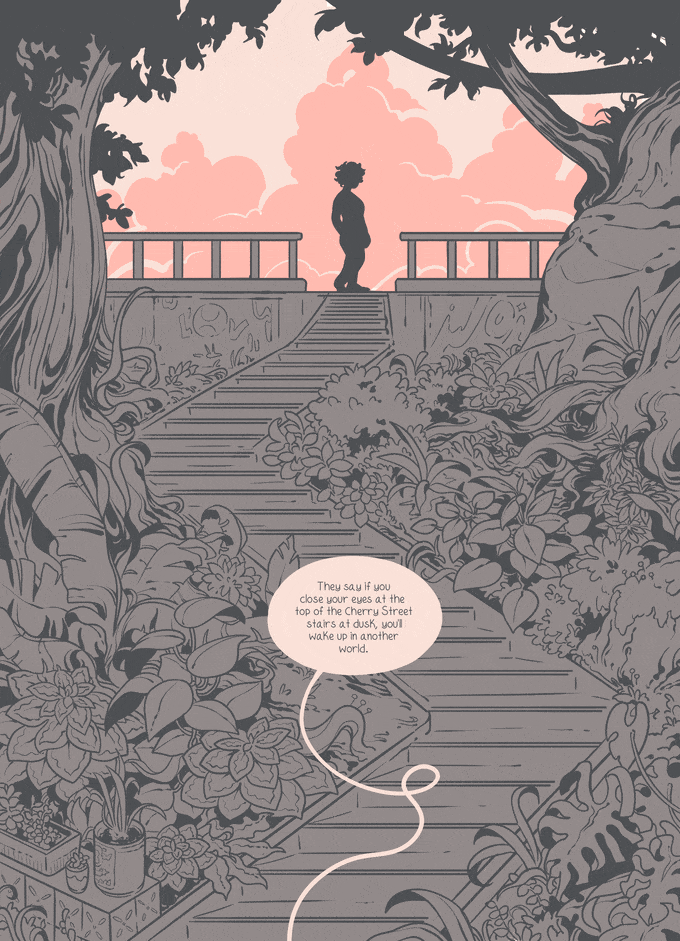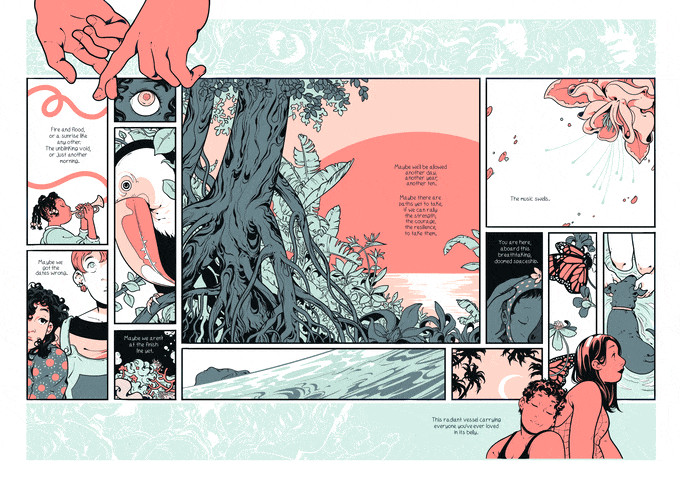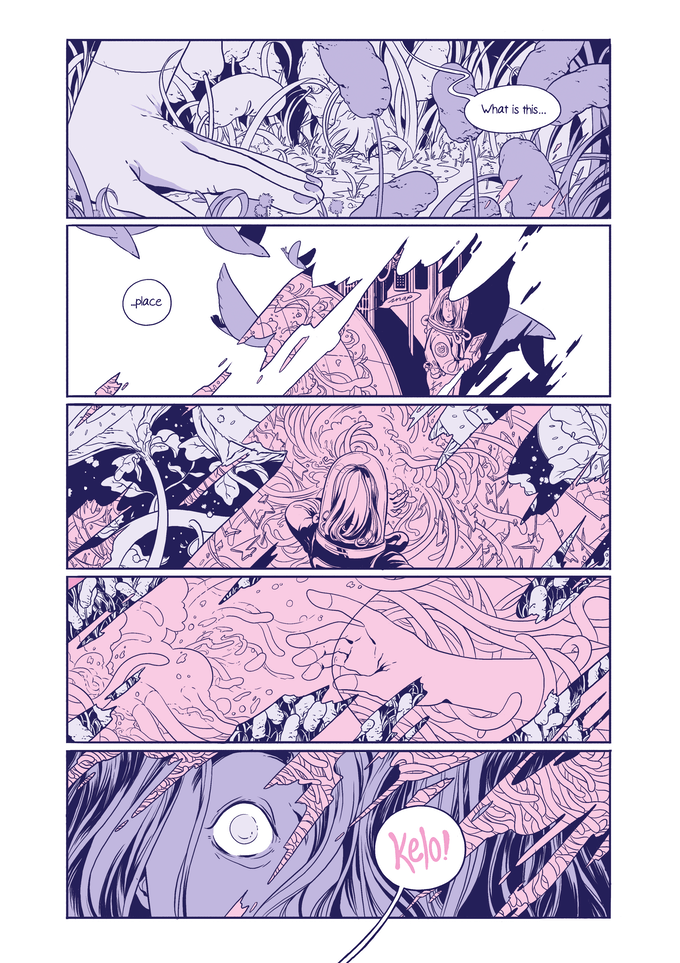What Memories Are Left: Memory, Dreams and Nostalgia in Don’t Go Without Me
- Fred McNamara

- May 2, 2023
- 10 min read
The blurb of Rosemary Valero-O’Connell’s Don’t Go Without Me is strikingly skeletal. A clutch of two, short paragraphs, one of which tells you the premises of the three short comics that make up the book and another that informs you who Rosemary is. It’s also the closest the book comes to revealing to you what it’s all about. Don’t Go Without Me defines itself as ‘a triptych of stories on love, loss, and connection…’ This brief summary passes by like the supernatural views seen by the character on the comic’s front cover, who is being transported through a surreal dimension of gorgeous monstrosities. Where love, loss, and connections are undoubtedly apparent themes throughout the comics included in this book, a much more solidifying and overarching theme at work is how memory can be a powerful tool of emotional release to achieve that connectivity.

Don’t Go Without Me began as a single comic, What Is Left, contained here alongside Con Temor, Con Ternura, and the self-titled comic itself. What Is Left was published by ShortBox in 2017, with this collected edition from 2020 reprinting the original comic and allowing Rosemary to flex her artistic and story-telling mechanics with these two additional stories. Whilst the bare nature of the book’s descriptions suggests that any in-depth interpretation may easily suit the subjective viewpoint applied is not only allowed, but the strategic placing of What Is Left as the second of the three comics also gives the impression that Rosemary has allowed that earlier comic’s emotionally driven atmosphere to lovingly spill over either side into the other two comics, enhancing their lucid aesthetic.
Indeed, these are comics with a strange, loose grip on reality. There’s a juxtaposing tranquillity at work in how unsettling their strange worlds are, with Rosemary’s narrative style crafting an inviting aura for the reader that reduces the anxieties that would otherwise naturally arise from such unnatural scenarios. Each comic boasts its unique colour palette, but all are recognisably linked through Rosemary’s subtle, confident artwork. These stories involve lovers searching for each other in a multi-cultural dimension, memories that power a spaceship, and a legend of an ancient giant awakening to deliver a sort of happy, wholesome rapture for those surrounding its slumbering form. Memory is at its most visible in What Is Left, the comic that anchors the other two, but in a lucid state like the comics themselves, memory slips around the other two stories, seemingly drifting around without force or harshness, yet undeniably firm components on close inspection. It’s that surface appearance that arrests you, however. These comics are made to give the impressions of gradually drifting in and out of conscious, dream-like, reality licking at your fingertips but just out of reach. These comics are visual snatches of memories that you can’t quite place but insist on lingering in your mind. There’s a quiet power at work in Don’t Go Without Me that rewards unboxing.

“They say if you close your eyes at the top of Cherry Street stairs at dusk, you’ll wake up in another world.”
This core idea of memory as something that needs to be extrapolated is a key narrative tool in Rosemary’s toolkit. The opening story, Don’t Go Without Me, centres on a nameless woman searching for her lover after the pair become separated in a surreal, uncanny valley-style dimension. Creatures of a decidedly non-human nature populate this bizarre land, aiding the sensation of our heroine being truly lost. As the comic progresses, the searcher gradually loses the memory of her partner more and more as she becomes more surrounded by the gently unfolding insanity around her.
We’re introduced to this character on the first page, but it isn’t until the twelfth page that we see her face, fully exposed, bathed in the pink and white hues of this peculiar world she’s in. This tactic of obscuring characters' faces is exploited throughout all three comics, a visual manifestation of memories eroding away. Rosemary pulls every possible tactic out of the bag to craft a sort of compassionate unease in Don’t Go Without Me, a world where everything is clearly not quite normal, but it isn’t treated as being wrong. This is a world we’re in no hurry to escape from. Whilst the comic’s lettering is consistently sharp and firm, not altering in appearance from speaker to speaker, the speech bubbles themselves curl around their speakers, like words are taking a while to form in the minds and mouths of the characters as they’re caught in this dream-like world. Panel structures are graceful and elegant, rarely tripping into extreme experimentalism.
As the heroine pulls herself through this world, she meets a variety of monstrous characters in otherwise regular places – market stalls, cafes, parties; locations become increasingly cramped and humid as her efforts to track down her lover meet stumble after stumble.
The vague, undefined ending to Don’t Go Without Me highlights the odd ebb and flow at work in these comics. Memory is depicted as remaining untangled in this first comic, as the nameless heroine ends her story by chancing upon, what may be, her lost partner. She too is looking for someone, but she can’t quite place her. The comic leaves their meeting as mystery yet to be enjoyed. A night of discovery remains palpable for the pair – where the story ends, the dream continues. As the pair confront each other, Rosemary presents the possible lover through a six-panel form, a portion of her face filling each one, a puzzle for the searcher to solve.
Don’t Go Without Me is a remarkably enchanting comic to open the book with. It isn’t as foreboding as What Is Left or as overpowering as Con Temor, Con Ternura. There’s an unhurried execution to the artwork of this particular story that isn’t apparent in the more chaotic energy of the other two comics. Rosemary’s razor-sharp sense of clean, economic detail leaves no stone unturned in this world, allowing its lungs to fully breathe and feel quite natural. The alluring sense of calm mixed with an unsettling aroma ensures that this book kickstarts its themes on a high.

“I don’t think I said more than ten words to you when we were on the ship together.”
In What Is Left, memory is presented in its most physical, literal form of the three comics. Biomechanic and astronaut Ilsa finds herself caught inside the memories of the person whose mind had been powering Ilsa’s spacecraft – prior to the unforeseen explosion of the craft itself. Drifting in space and caught in the wreckage, Ilsa’s physical form is caressed within the craft’s detonated memory core whilst she drifts within the memories of donor Kelo. Ilsa is rendered a passive passenger, watching the existence of the person whose mental faculties had previously kept her safe.
The dominant citrusy glow of Don’t Go Without Me morphs into a fragrant mix of pinks and purples for What Is Left. The art appears jagged, the wreckage of Iilsa’s spacecraft blending with her mess of dark hair as she adjusts to having Kelo’s life replayed for her in stabbing bursts of randomness. The art succeeds in communicating a sense of unpredictable urgency, reflecting Ilsa’s situation. Despite the story taking place in deep space, we spend much of the story alongside Ilsa within Kelo’s memories. Rosemary makes no distinction between reality and memory, using colour and form to blend the two types of location together. Interestingly, Rosemary uses a fair amount of overhead panel shots, looking down into Ilsa wading her way through Kelo’s past. It feels intrusive, unwelcome. As if Rosemary wants us to share in Ilsa’s awkwardness.
Entrapped in someone else’s mind, Ilsa gradually attempts to communicate with Kelo, knowing full well that she can’t answer back. She’s living inside a static, predetermined set of events that, presumably, happened long ago, but that doesn’t stop Ilsa from continuing to attempt to bond with Kelo, sharing her own past with someone who can’t respond. Just as Ilsa begins to share details about herself of a more intimate, personal nature, her connection is broken by the arrival of a rescue ship, contacting her from outside of the memory core, from reality. The comic ends on another vague note, but this time it’s far more melancholic. Ilsa appears too dumbstruck to respond to the rescue craft. Tears begin to stream down her cheeks. The artificial sun and sky, generated from Kelo’s memories, compel Ilsa to remain lovingly enwrapped inside Kelo’s past, rather than face the harsh, bleak wreckage of reality.
The message at work here is a toxic comfort of nostalgia, a kind that isn’t even your own. Ilsa is reliving a life that isn’t hers but comes to realise she has taken it for granted when Kelo was nothing more than another component of her spacecraft. She gains a newfound warmth for Kelo when she sees the memories that had been powering her machine at play. Strangely, despite the aforementioned panel method in showing Ilsa’s bolted-on presence in Kelo’s mind, Rosemary doesn’t illustrate Ilsa herself in a similarly intrusive fashion. She softly weaves Ilsa into Kelo’s life, always talking but never intruding.
Throughout What Is Left, memory is shown to be something that Ilsa clings onto for survival, only to not want to let go of it once reality beckons. The comic’s penultimate page consists of three panels – two of Ilsa’s shocked face, both of which frame a larger panel of Kelo’s memory of a summer’s sky, resplendent in its artificial form. Rosemary condenses only sections of Ilsa’s face into the two smaller panels above and below the sun-kissed middle, her incomplete face suggesting Ilsa is overwhelmed by the choice she must make, cut it into shards, torn between multiple options. Or perhaps it’s meant to show how crushing nostalgia is, that Rosemary doesn’t need to show all of Ilsa’s face to convey precisely the torment gnawing away inside of her. It’s an intensely cryptic manner that the comic ended.

“When will it wake? What happens if it does?”
Don’t Go Without Me feels at its most opaque in its third and final comic; Con Temor, Con Terunar. More strategic placing comes to mind in how the most otherworldly story should be the one to close out the book. If Don’t Go Without Me’s core theme of memory is the solution to resolve our inability to connect to each other, then there’s the definite sense that Con Temor, Con Terunar inverses this.
Unlike the first two stories, there is no protagonist to this final tale. An unseen narrator guides us through the voluminous anticipation and suspected consequences of what will happen when an ancient, slumbering giant awakens from its deep sleep. People travel from all over the world to marvel at its comatose form and to witness its rumoured ascension. Some believe the giant will punish humanity, whilst others believe it will salvage them. Rosemary’s art is at its most luscious here. We’re no longer in outer space or another dimension – the world of Con Temor, Con Terunar is recognisably normal, yet its existence is anchored by the presence of this statuesque being, its island-like body giving rise to legend and shaping the world around it. Rosemary’s art communicates this with delicate precision. She stuffs the comic with communities and cultures to reflect the all-encompassing allure the giant has. Panels are packed with showing the varying community spirits that emerge out of the strangers who join to see what might happen.
Rosemary’s tactic of obscuring characters’ faces reaches a natural extreme here. She relies almost entirely on close-ups of these swathes of people, to the point where everyone is huddled together and not able to show their faces. The result is a mass of noise, a busy, bustling sensation that ripples throughout the comic.
Where the giant came from is left a mystery, said to be lost “in the memories of the dead” – a far cry from memory being treated as something so nearly in reach throughout the previous two comics. The achieving of memory isn’t the solution to people’s anxieties in Con Temor, Con Terunar. Instead, Rosemary shows us how people take comfort in each other as spontaneous celebrations erupt around the sleeping giant, but the anxiety still lingers. Near the comic’s climax, a gorgeous splash page of a blistering sun and rising tide, indicative of something grand about to occur, is adorned by two speech bubbles: “What will you do if it wakes up?” “What will you do if it doesn’t?” People’s anxieties aren’t entirely let go of – they are merely parked, even if the people find reassurances in their collective presence. The idea of remembering what came before, so apparent in the first two stories, feels like it’s quietly discarded in favour of people creating new memories to take into the giant’s awakening.
The splendid sense of communal business radiates across these pages, barriers being washed away with effortless ease. Rosemary favours concise rectangular panels, occasionally overlapping, but mostly self-contained to capture individual moments and personalities – fear, joy, sadness, excitement. The colour palette helps to contain all this activity, preventing it from slipping into unfocused messiness. There’s a particular usage of colour to separate people from their natural surroundings. Cityscapes are noticeably absent in Con Temor, Con Terunar, with the story taking place in an idyllic, coastal countryside.
Only in the comic’s climax do events lose their pleasantness and turn more foreboding. Through a curved, smothering sense of perspective on the reader’s part and awash in darkly aquatic colours, a surge of physical change appears to occur, its specifics distorted, its sensations overpowering. Rosemary ensures that Don’t Go Without Me concludes on a literal wave of emotion. Whilst the giant isn’t readily visible within these final scenes, an inescapable sense of confronting your anxieties feels like what’s at work here. Where you may end up afterwards isn’t revealed, but it’s the confrontation that matters most.
Rosemary is quite content to plunge the reader deep into these melancholically abnormal worlds. She doesn’t push us over the edge, but instead softly pulls us in and doesn’t entirely release us back into normality. Throughout Don’t Go Without Me, colours and shapes swell together into surreal concoctions that rarely overpower the reader. Where the morals of the comics may be a warning in their crisscrossing motifs of memory and its aftershocks of emotional ripples, Rosemary imbues them with such clean, soft colours and radiant inks. These are such lovely comics to sink into.
Memory finds room to gently manoeuvre in a variety of ways in these comics. It glides with love, desperation, anger, yearning, anxiety, and joy. It’s rare that Don’t Go Without Me should show memory eliciting positive feelings, choosing instead to carry the reader on a wave of gorgeously rendered introspection. That Rosemary can inject a conflicting sensation within you of confronting uncomfortable emotions by presenting them in such spellbinding artwork encapsulates the dream-like, memory-propelled wandering of Don’t Go Without Me.









